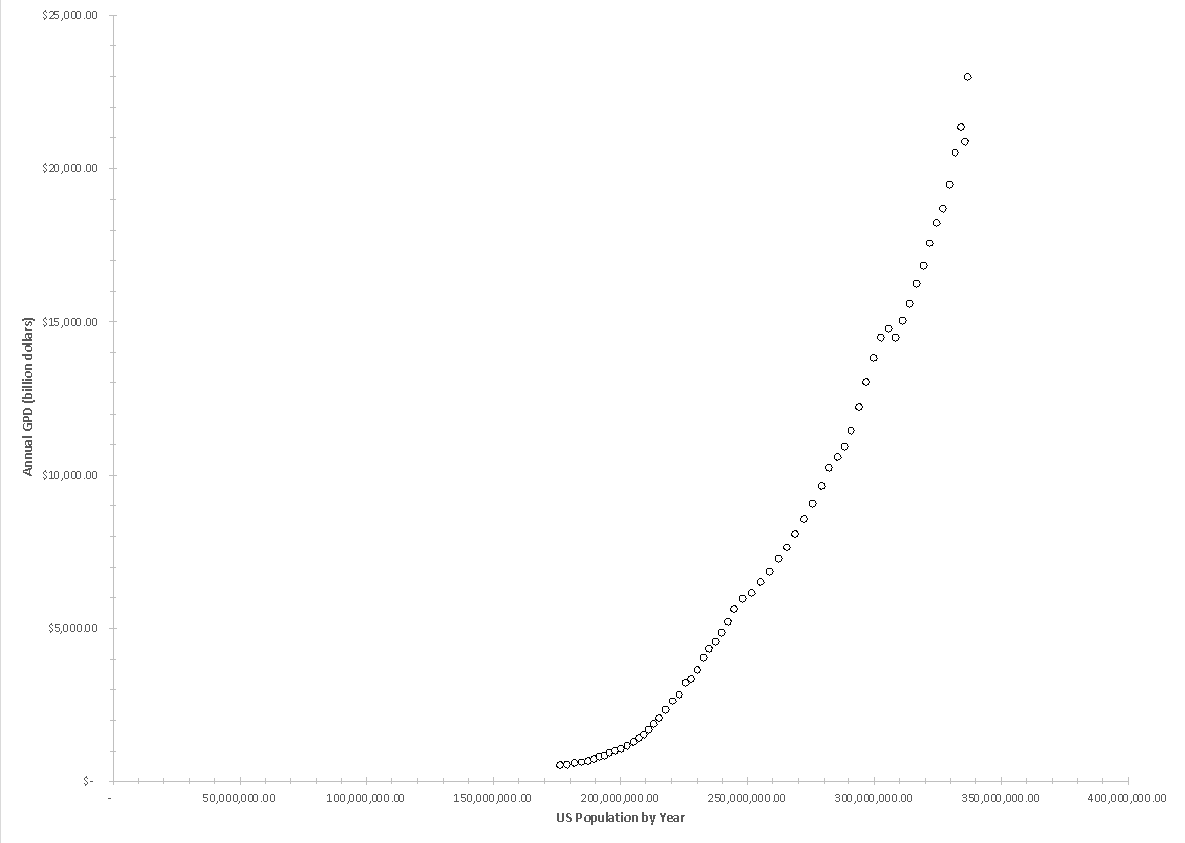Introduction
The study of national macroeconomic trends is of particular importance for the effective management of a country, as it makes it possible to detect potentially hidden patterns. For this purpose, the study of dependencies between variables is often used to identify causes and effects affecting the well-being of the population as a whole. In this paper, a pair of such variables is the U.S. population and the absolute value of the annual gross domestic product. While population size quantifies precisely how many people are registered in the U.S. for a given year, GDP shows the monetary equivalent of all goods and services produced in the country for the year passed (The World Bank, 2022; Macrotrends, 2022). The relationship between the two variables could be interesting: potentially, an increase in population could also increase GDP as more consumers and producers are born in the country. This is the central hypothesis of this analysis: an increase in the U.S. population leads to an increase in annual GDP. The report presents a statistical study of this relationship and elaborates on the stated hypothesis.
Statistical Analysis
Figure 1 shows the scatterplot for the dependence of annual GDP on population size. It is easy to see that the data form a shape similar to the right branch of an open upward parabolic function. It follows that it can be assumed that population growth leads to an increase in annual GDP squared. It is essential to distinguish between a quadratic and an exponential function: the exponential shows a much more rapid rate of growth than the quadratic (Logan, 2022). In this case, the relationship between the variables might look like GDP = (Population)2, which would correspond precisely to the quadratic function, but not the exponential GDP = ePopulation. In other words, this relationship shows neither a logarithmic nor an exponential form of the relationship between the variables.

For a pair of variables, it is possible to perform a regression analysis, one of the parameters of which is the coefficient of determination. This coefficient, or R2 for short, determines the degree of reliability of the constructed model for the variance of the data; in other words, the closer the value of R2 is to 1, the better the fit between the model and the data set. As seen in Figure 2, the coefficient of determination, in this case, is 0.997, which means that the quadratic model explains up to 99.7% of the variance in the dataset. This is an extremely high level of fit, justifying the choice of a polynomial model for a pair of variables. Figure 2 also reports information about the regression equation for the relationship: this equals GDP = 7∙10-13[Population]2-0.0002[Population]+17.361: the right branch of the parabola is shown in the figure.

The resulting equation can be used to forecast GDP in a particular year: the reliability of such a forecast would be exceptionally high for values within the 1960 to 2021 period for which the data were collected. For example, with a population of 200 million people reached between 1969 and 1970, the projected GDP is $5.361 billion, and with a population of 300 million, it is $20.361 trillion. Since these numbers are within the range of the data, the probability of them matching the actual values is extremely high. The accuracy of subsequent years decreases but can still be quite reliable given the R2 level and the tendency for polynomial growth. Hence, for example, when the U.S. population is 350 million, GDP will tentatively be $33.111 trillion, and when the population is 400 million, GDP could be $49.361 trillion. In reality, the actual numbers will probably be different from these values, but a good regression model can give indicative levels.
Conclusion
To summarize, it should be emphasized that a statistical study of dependencies for real data can provide valuable information about the causal relationships between them. The current paper showed that the size of the annual GDP for the United States had been quadratically related to population size over the past six decades. Determination coefficient and regression equation values were obtained for this data set. The equation is used to produce predictive estimates that were highly accurate due to the numbers falling within the population range and the high R2 level. Taken together, this suggests that an increase in population leads to a quadratic increase in annual GDP in the United States.
References
Logan. (2022). What is the difference between quadratic and exponential functions? (Difference explained). All The Differences.
Macrotrends. (2022). U.S. population 1950-2022[Data set].
The World Bank. (2022). GDP (current US$) — United States [Data set].